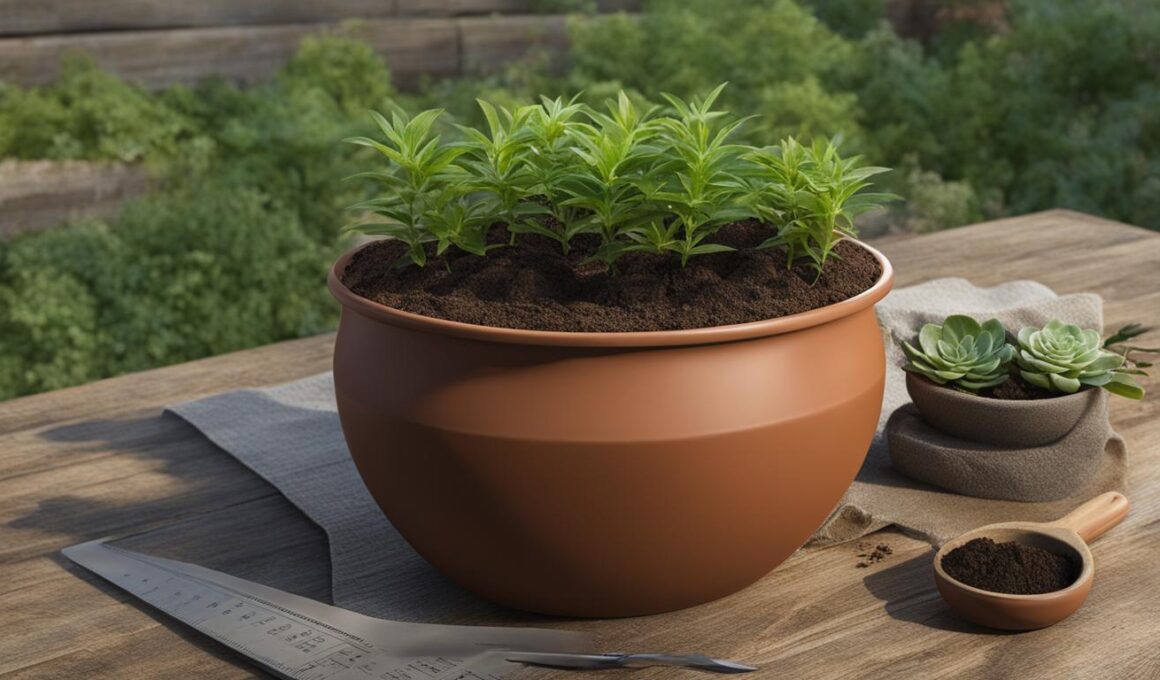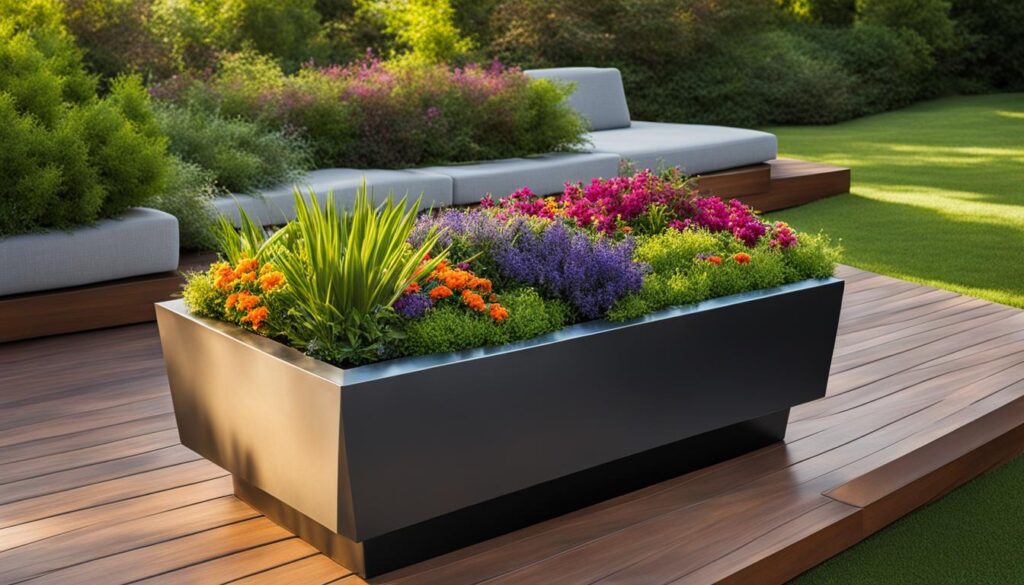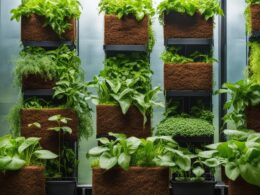Choosing the right pot size for your plants is crucial for their overall well-being. A pot that is too small can hinder growth, while a pot that is too big can lead to root rot. In this guide, we will delve into the details of pot sizes and provide tips for selecting the ideal pot size for your plants.
Key Takeaways:
- Understanding pot sizes is essential for plant health and growth.
- Pot sizes are typically measured in inches or gallons.
- Avoid overcrowded roots by choosing an appropriate pot size.
- Repotting into a larger container may be necessary as plants grow.
- Select durable and weather-resistant materials for long-lasting pots.
Understanding Pot Sizes and Measurements
Pot sizes are typically measured in either inches or gallons. Inches refer to the diameter of the pot opening, while gallons indicate the container’s volume. A general rule of thumb is that a 1-gallon pot is equivalent to 8 inches in diameter. For every increase of 2 inches in pot diameter, the pot size increases by 2 gallons.
When selecting a pot, it’s important to consider whether the measurement refers to the diameter or volume. This will help you choose the appropriate size for your plants. For example, if you have a plant that requires a 10-inch pot, you would need to select a pot that can hold at least 2 gallons of soil. Knowing the measurement system and understanding the relationship between inches and gallons will ensure you choose the right pot size for your plants.
Choosing the Right Pot Size
- Measure the diameter of your plant’s root ball.
- Refer to a pot size conversion chart to determine the appropriate pot size based on the diameter measurement.
- Consider the growth potential of your plant. If it’s a fast-growing plant or one that will likely grow large, choose a pot slightly larger than recommended to allow room for future growth.
- Take into account the plant’s watering needs. If the plant prefers to dry out between waterings, a smaller pot may be suitable. If the plant requires more water, opt for a larger pot that can hold more soil and retain moisture.
By understanding pot sizes and measurements, you can confidently choose the right pot size for your plants, promoting their health and growth.
The Importance of Pot Size for Plant Health
Choosing the right pot size is vital for plant health. When a plant’s roots become overcrowded in a small pot, it can lead to stunted growth and dehydration. The roots may pack the soil, making it difficult for water to penetrate, resulting in wilted, yellow, or brown leaves.
On the other hand, if a pot is too large, excess water can accumulate, causing root rot and depriving the roots of necessary oxygen. This can further impede the plant’s growth and overall well-being.
Observing your plants for signs of root-boundness or overwatering is crucial. If you notice that the roots are circling around the inside of the pot or if water is pooling at the bottom, it’s time to make appropriate pot size adjustments to promote healthy growth.
By providing your plants with the right pot size, you can ensure they have enough space for their roots to grow and access the necessary water and nutrients. This will help prevent issues such as root-boundness, stunted growth, root rot, and overcrowded roots, ultimately promoting healthier and flourishing plants.
Tips for Choosing the Best Pot Size
When it comes to choosing the best pot size for your plants, there are a few key factors to consider. These tips will help ensure that your plants have the right amount of space to grow and thrive:
- Observe your plants: Keep an eye on your plants and look for signs that they may need to be repotted. If you notice roots protruding from the drainage holes or the plant becoming top-heavy, it’s a good indication that it’s time to upgrade to a larger pot.
- Consider the size of your plant: Smaller plants, such as herbs or young seedlings, will generally require smaller pots. A 10- to 12-inch pot should be sufficient for small plants. On the other hand, larger plants, such as shrubs or trees, will need larger pots to accommodate their root systems. Opt for 14- to 18-inch pots for larger plants.
- Choose a pot with proper drainage: Proper drainage is essential for plant health, as it helps prevent waterlogged soil and root rot. Look for pots with drainage holes at the bottom to allow excess water to escape.
- Consider pot fillers for small plants: If you have small plants in tall pots, consider using pot fillers to help aerate the soil. These fillers, such as stones or perlite, can prevent overwatering and promote healthy root development.
Remember, these are general guidelines, and the specific needs of your plants may vary. It’s always a good idea to research the specific requirements of your plant species and consult with a garden center or pot manufacturer for more precise recommendations.
Finding the Right Pot Material
When it comes to selecting a pot for your plants, choosing the right material is crucial. Plastic pots are a popular choice due to their affordability and availability. However, they may not be as durable or weather-resistant as other options. Plastic pots can crack or break, especially when used outdoors and exposed to harsh weather conditions. If you’re looking for a more durable and long-lasting option, fiberglass planters are an excellent choice.
Fiberglass planters are known for their exceptional durability and weather-resistance. They are designed to withstand varying temperatures, humidity levels, and weather elements. Whether you place them indoors or outdoors, fiberglass planters will maintain their structural integrity and aesthetic appeal. Additionally, they require minimal maintenance, making them a convenient choice for busy plant enthusiasts.
Benefits of Fiberglass Planters:
- Extreme durability: Fiberglass planters are resistant to cracking, breaking, and fading, ensuring their longevity.
- Weather-resistant: They can withstand both extreme heat and freezing temperatures without compromising their structural integrity.
- Lightweight: Despite their durability, fiberglass planters are lightweight and easy to move around.
- Versatile design options: Fiberglass planters come in a wide range of shapes, sizes, and colors, allowing you to find the perfect match for your plants and decor.
- Root insulation: Fiberglass planters provide insulation for plant roots, protecting them from temperature fluctuations and promoting healthy growth.
By opting for fiberglass planters, you can ensure the durability, longevity, and overall health of your plants. Their weather-resistant properties and low-maintenance nature make them a reliable choice for any indoor or outdoor gardening project.
Standard Planter Size Chart
Choosing the right pot size for your plants is crucial for their growth and overall health. To help you in this process, we have provided a standard planter size chart that offers approximate pot sizes and equivalencies for various plant types. By referring to this chart, you can easily match your plants with the appropriate pot dimensions.
Here are some examples from the standard planter size chart:
- In a 10-inch pot, you can accommodate small herbs or up to 3 annuals.
- A 14-inch pot is suitable for medium-sized perennials or small shrubs.
- If you have evergreen shrubs or a dwarf citrus tree, a 24-inch pot would be ideal.
Please note that these are general guidelines and pot sizes may vary depending on the brand and shape. It’s always advisable to consult with a garden center or pot manufacturer for precise recommendations based on the specific needs of your plants.
Conclusion
Choosing the right pot size is crucial for optimizing the growth of your plants. By following pot size guidelines and considering the specific needs of your plants, you can create an ideal environment for them to thrive and flourish.
Too small of a pot can result in crowded roots and stunted growth. On the other hand, a pot that is too large can cause excess water accumulation and lead to root rot. It’s important to find the right balance to ensure the overall well-being of your plants.
By understanding pot size measurements and regularly repotting when necessary, you can provide adequate space for your plants’ roots to spread out and absorb nutrients effectively. Additionally, considering the appropriate pot size for each plant type will help promote healthy growth and development.
Remember, choosing the right pot size is just as important as providing proper sunlight, water, and nutrients. So, take the time to evaluate your plants’ needs and select the perfect pot size to optimize their growth and create a thriving plant ecosystem in your home or garden.
What is the relationship between pot size and soil volume when gardening in a 6 inch pot?
When considering the appropriate soil amount for a 6 inch pot, it’s important to remember that the size of the pot will directly impact the volume of soil needed for healthy plant growth. A 6 inch pot will have a limited soil volume, so it’s crucial to choose plants that can thrive in this confined space.
FAQ
How do I determine the right pot size for my plants?
The pot size for your plants can be determined by considering the plant’s current size and growth rate. If the roots are peeking through the drainage holes, it’s time to repot into a larger container.
What are the consequences of using a pot that is too small?
Using a pot that is too small can lead to crowded roots, stunted growth, and dehydration. Over time, the roots may compact the soil, making it difficult for water to penetrate.
What happens if I use a pot that is too big?
A pot that is too big can cause excess water accumulation, which can result in root rot and oxygen deprivation for the roots.
How often should I repot my plants into a larger pot?
It is recommended to upgrade to a larger pot every 1-2 years to accommodate plant growth and prevent root-boundness.
What types of pots are durable and weather-resistant?
Fiberglass planters are a preferred option as they are extremely durable, weather-resistant, and easy to maintain. They can be used both indoors and outdoors.
Is there a standard planter size chart I can refer to?
Yes, a standard planter size chart can be helpful in selecting appropriate pot sizes for specific plants. The chart provides approximate pot sizes and equivalencies, allowing you to match plant types with the right pot dimensions.











